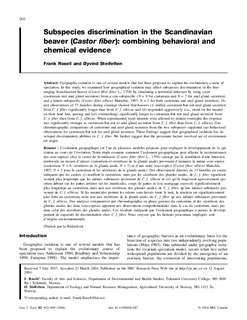Subspecies discrimination in the Scandinavian beaver (Castor fiber): combining behavioral and chemical evidence
Journal article, Peer reviewed
Permanent lenke
http://hdl.handle.net/11250/2438047Utgivelsesdato
2004Metadata
Vis full innførselSamlinger
Originalversjon
Canadian journal of zoology 82 (2004), No. 6, p. 902-909 http://dx.doi.org/10.1139/z04-047Sammendrag
Geographic isolation is one of several models that has been proposed to explain the evolutionary course of speciation. In this study, we examined how geographical isolation may affect subspecies discrimination in the free-ranging Scandinavian beaver (Castor fiber fiber L., 1758) by simulating a territorial intrusion by using scent (castoreum and anal gland secretion) from a con-subspecific (N = 8 for castoreum and N = 7 for anal gland secretion) and a hetero-subspecific (Castor fiber albicus Matschie, 1907; N = 2 for both castoreum and anal gland secretion). Direct observations of 33 families during evenings showed that beavers (i) sniffed castoreum but not anal gland secretion from C. f. fiber significantly longer than from C. f. albicus and (ii) responded aggressively (i.e., stood on the mound on their hind feet, pawing and (or) overmarking) significantly longer to castoreum but not anal gland secretion from C. f. fiber than from C. f. albicus. When experimental scent mounds were allowed to remain overnight, the response was significantly stronger to castoreum but not to anal gland secretion from C. f. fiber than from C. f. albicus. Gas chromatographic comparisons of castoreum and anal gland secretion from the two subspecies supported our behavioral observations for castoreum but not for anal gland secretion. These findings suggest that geographical isolation has developed discriminatory abilities in C. f. fiber. We further suggest that the proximate factors involved are of environmental origin.
